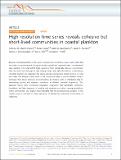High resolution time series reveals cohesive but short-lived communities in coastal plankton
Author(s)
Cleary, Brian; McGillicuddy, Dennis J.; Martin Platero, Antonio; Kauffman, Anne Kathryn Marie; Preheim, Sarah P.; Alm, Eric J; Polz, Martin F; ... Show more Show less
Downloads41467-017-02571-4.pdf (1.507Mb)
PUBLISHER_CC
Publisher with Creative Commons License
Creative Commons Attribution
Terms of use
Metadata
Show full item recordAbstract
Because microbial plankton in the ocean comprise diverse bacteria, algae, and protists that are subject to environmental forcing on multiple spatial and temporal scales, a fundamental open question is to what extent these organisms form ecologically cohesive communities. Here we show that although all taxa undergo large, near daily fluctuations in abundance, microbial plankton are organized into clearly defined communities whose turnover is rapid and sharp. We analyze a time series of 93 consecutive days of coastal plankton using a technique that allows inference of communities as modular units of interacting taxa by determining positive and negative correlations at different temporal frequencies. This approach shows both coordinated population expansions that demarcate community boundaries and high frequency of positive and negative associations among populations within communities. Our analysis thus highlights that the environmental variability of the coastal ocean is mirrored in sharp transitions of defined but ephemeral communities of organisms.
Date issued
2018-01Department
Massachusetts Institute of Technology. Department of Biological Engineering; Massachusetts Institute of Technology. Department of Civil and Environmental EngineeringJournal
Nature Communications
Publisher
Nature Publishing Group
Citation
Martin-Platero, Antonio M. et al. “High Resolution Time Series Reveals Cohesive but Short-Lived Communities in Coastal Plankton.” Nature Communications 9, 1 (January 2018): 266 © 2018 The Author(s)
Version: Final published version
ISSN
2041-1723